Abstract
In the second half of the 19th century, a wave of modernization, industrialization and urbanization swept the Nordic countries, catapulting what had until then been lagging and primarily rural countries into modernity. These major upheavals, however, also plunged the Nordic countries into a profound social and cultural crisis resulting from their consciousness of their own backwardness vis-a-vis the countries on the European continent, as well as the recognition that a nostalgic nationalism recalling a mythical past had become obsolete in the industrial age. In response to this crisis, a life reform movement emerged that was based on Arts and Crafts movements as well as various artistic and literary reform movements and—equally absorbing rural traditions and progressive social ideas—tried to establish a new national everyday culture. In this article, the two key terms coined by Ellen Key, “Festive Customs” (“festvanor”) and “Everyday Beauty” (“vardagsskönhet”)—the programmatic core of the Nordic life reform movement—are analysed and illustrated in various typical manifestations. It also examines to what extent the Nordic life reform movement with these two key concepts as its core agenda found expression in arts and crafts, in painting as well as in the architecture of the late nineteenth and early twentieth century and contributed to the progress of social and cultural renewal.
Keywords:
art history; Nordic countries; life reform movement; Ellen Key; 19th century; 20th century 1. Introduction
In the second half of the 19th century, a wave of modernization, industrialization and urbanization swept the Nordic countries, catapulting what had until then been lagging and primarily rural countries on the margins of Europe into modernity. It set off various social upheavals similar to those which had occurred some decades before, first in England, the cradle of the Industrial Revolution, and later on the European continent as well. The late onset of this modernization led to all the more drastic consequences, with urbanization and industrialization proceeding very fast, and, for instance, the housing situation in Sweden around the turn of the 20th century being described as the worst anywhere in Europe. One aspect of this modernization, however, was a growing openness towards other countries. Close ties, prompted by felt affinities, developed with the German Empire, for example, which was adopted as a model to be followed in the spheres of technology, science and art. At the same time, numerous Nordic artists and writers were drawn to the European continent, especially to France and Germany, where some were more successful than in their home countries (Henningsen et al. 1997). These major upheavals also plunged the Nordic countries into a profound social and cultural crisis resulting from their consciousness of their own backwardness vis-a-vis the countries on the European continent, as well as the recognition that a nostalgic nationalism recalling a mythical past had become obsolete in the industrial age and could no longer suffice as the foundation of a cultural identity (Häfner 1998, pp. 5–9).
In response to this crisis a life-reformist movement of renewal arose, drawing strength from the Arts and Crafts movement as well as a variety of artistic and literary reform movements. Building equally on folk traditions and progressive social ideas, it attempted to establish a new national culture in everyday life. At the centre of this movement are the two concepts of “Festvanor” (“Festive Customs”) and “Vardagsskönhet” (“Everyday Beauty”) formulated by the Swedish author and educational reformer Ellen Key (1849–1926). Her eponymous essays (Key 1891, 1896) express a longing for a renewed festive ritualising and aesthetic enrichment of everyday life.
This article presents the two key terms “Festive Customs” and “Everyday Beauty” as comprising the basic agenda for the Nordic life reform movement and describes some of their typical manifestations, such as the artists’ celebration or festive rituals. In so doing it also examines the question of to what extent the Nordic life reform movement with these two key concepts as its core agenda found expression in arts and crafts, in painting as well as in the architecture of the late nineteenth and early twentieth century and contributed to the progress of social and cultural renewal.
2. Ellen Key in Her Contemporary Context
2.1. Aesthetic Lifestyle Reformer and Patriot
Ellen Key was born in 1849 on the southern Swedish estate Sundholm, to a family of landed gentry that later moved to Stockholm. In 1875 she began teaching and in 1883 to lecture at the Swedish Workers’ Institute. In these years she progressed through lectures, publications, and a wide range of personal contacts to become one of the leading intellectuals of the country. In her works Ellen Key promoted equally artistic, literary and political goals. Her contacts included representatives of new artistic and literary currents, such as the group of painters known as “Opponenterna” (“The Opponents”) founded in 1885, which included among others Carl Larsson (1853–1919), Richard Bergh (1858–1919) and Georg Pauli (1855–1935), and the writers who called themselves “Det unga Sverige” (“The young Sweden”), including Gustaf af Geijerstam (1858–1909) and Victoria Benedictsson (1850–1888). In her political work, Ellen Key advocated the rights of the rural poor, the proletariat, and in particular of women. She was the founder and co-founder respectively of the women’s rights organizations “Tolfterna” (“The twelve”) and “Nya Idun” (“New Idun”). She was also a supporter of the socialist leaders August Palm (1849–1922) and Hjalmar Branting (1860–1925) and after the founding of the Swedish Social Democratic Party in 1889 appeared at party events. The circle of like-minded “enlightened radicals” which collected around Ellen Key and called themselves “Sällskapet Junta” (“The Junta Society”) can be regarded as one of the nuclei of the life reform movement. It included the painters Richard and Gerda Bergh (1864–1919), Carl and Karin Larsson (1859–1928), Anders Zorn (1860–1920) and Georg and Hanna Pauli (1864–1940); the art historian Carl G. Laurin (1868–1940); and the publisher Karl Otto Bonnier (1856–1941) and his wife Lisen (1861–1952). They met weekly in the home of Ellen Key or Hanna Pauli for discussions about socialism, pacifism, education, philosophy, religion and art. Hanna Pauli’s painting “Vännerna” (“The friends”, 1900–1907; Figure 1) captures such a meeting in her home, where Ellen Key is reading to the group of friends (Ambjörnsson 2012; cf. Lane 2008).
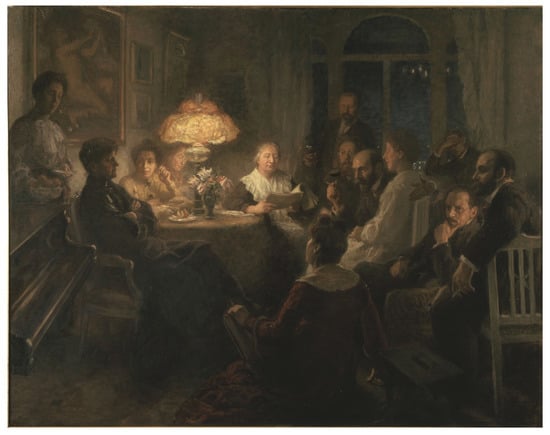
Figure 1.
Hanna Pauli (1864–1940): Vännerna (“The Friends”), 1900–1907, oil on canvas, 204 cm × 260 cm, Nationalmuseum Stockholm, Public domain.
In her works, Ellen Key engages with a great number of natural science and humanist viewpoints, ranging from the evolutionary theories of Charles Darwin (1809–1882) and Ernst Haeckel (1834–1919), to the philosophy of Søren Kierkegaard (1813–1855) and Friedrich Nietzsche (1844–1900) (Wittrock 1953). In particular, Nietzsche’s summoning of a golden age, in which the total festival promises liberation—“Singing and dancing, man expresses himself as a member of a higher community [...]. Man is no longer an artist; he has become a work of art.” ((Nietzsche 1954, p. 24 f.), quoted in (Assmann 1989, pp. 244–45))—leads to a reinterpretation of aesthetic into festive experience, to the demand for a unity of art and life. Nietzsche’s influence also helped to dismantle encrusted historic values, religion in particular, and to promote cultural renewal. These thoughts are reflected in Ellen Key’s writings, especially in Beauty for Everyone, in a manner similar to that expressed by other proponents of youth and reform movements (Berggren 1995, pp. 40–49; cf. Assmann 1989, pp. 243–46).
Ellen Key’s work cannot be definitively classified as progressive or conservative, which to some extent is typical of the life reform movement in the Nordic countries. Although a campaigner for women’s rights and later a role-model for young urban women, she was branded by some as an anti-feminist, for example by Hedwig Dohm (1831–1919), for maintaining that motherhood was a woman’s calling and that her natural place was in the home (Ambjörnsson 2012, pp. 221–359; cf. Lane 2008, pp. 19–23).
Ellen Key exerted a major cultural and social influence far beyond the Junta Society and Sweden. Her numerous articles and other writings, in which she dealt with a wide spectrum of themes, were repeatedly collected in anthologies and translated into practically all European languages (Ambjörnsson 2012, pp. 575–84). Her works on feminism and pedagogy had the greatest impact, especially her book Barnets århundrade (“The Century of the Child”, (Key 1900a; cf. Ambjörnsson 2012, pp. 135–219)). She also undertook, especially in the early decades of the 20th century, extended lecture tours throughout the world and a great variety of people, from the authors Selma Lagerlöf (1858–1940) or Rainer Maria Rilke (1875–1926) to the American architect Frank Lloyd Wright (1867–1959), read her works and were lastingly influenced by them (Ambjörnsson 2012, pp. 361–532; Friedman 2002).
Typical of the life reform movement’s striving for national and cultural renewal is the dispute that Ellen Key waged in 1896 and 1897 with the New Romantic poet Verner von Heidenstam (1859–1940). The latter describes Sweden in his essay “Om svenskarnes lynne” (“On the character of Sweden”) as a “widely travelled old man of the world, who has seen everything and tried everything” and is yet “rich in opportunities”, but stands in the autumn of his life bent by age and burdens (Heidenstam 1896, p. 1; cf. Häfner 1998, pp. 13–18). Ellen Key criticises this anciennity-thinking in her essay “Om patriotism” (“On Patriotism”) as an obsolete national identity which is frozen as “commemorative stones, tombstones and memorial statues” and a ceremonial festive rhetoric, the most extreme expression of which is the national anthem, a pure homage to the monarch—the monarchy being the most prominent symbol for the obsolete old (Key 1897a). She concludes that the national identity needs a cultural and political renewal. The national culture has to be re-invigorated from folk culture and the political conditions democratised. Here the artistic and moral education of the new populace plays a crucial role. According to Key, this would take place less in school, but more at home. She takes her lead in this respect from the Norwegian art and literary historian Lorentz Dietrichson (1834–1917), who regards a beautiful home as the prerequisite for a beautiful, healthy and moral society. Ellen Key maintains that, building on the beauty of the home, the new “religion of beauty” would conquer architecture and urban life, ennoble everyday life and ultimately transform the entire society (Sheffield 1997, pp. 35–43; Häfner 1998, pp. 25–35).
2.2. Arts and Crafts and Industry
The idea of cultural renewal through “Everyday Beauty” and a return to rural or folk handcrafts is not Ellen Key’s invention, but rather an inheritance from the Arts and Crafts movement, which opposed the vulgar urban mass culture of the industrial age, i.e., the increasing industrial mass production throughout the second half of the 19th century. In the Nordic countries these ideas were advocated most loudly by the national romantic movement in Norway. Firstly, in 1837 the landscape painter Johan Christian Dahl (1788–1857) praised the exemplary artistic quality of the traditional Nordic wooden building style. Later this theory became most prominently represented by the Norwegian national antiquarian Herman Major Schirmer (1845–1913) and the so-called “Schirmer school” he influenced (Lane 2000, pp. 19–48).
In Sweden, on the other hand, the Arts and Crafts movement in the latter half of the 19th century was more strongly characterised by its interest in industrial production. Following the repeal of guild laws and the removal of tradesmen’s monopolies, the Swedish Arts and Crafts Association (Svenska Slöjdföreningen) was founded in 1845. It was to ensure the quality of craftsmen’s products (Frick 1978, pp. 14–62). However, in the steadily expanding exhibitions which the Association arranged in the second half of the 19th century, the thematic focal point shifted. Following the example of international exhibitions, and in step with advancing industrialization, this moved increasingly from the presentation of domestic art and craft products to the exhibition of industrial products (Sörenson 1999).
The largest of these exhibitions was Allmänna konst- och industriutställningen 1897 in Stockholm or Stockholmsutställningen 1897 (General Art and Industry Exhibition 1897, in short The Stockholm Exhibition 1897), which was largely dominated by the presentation of technical and industrial achievements (Figure 2). Some 3.700 exhibitors from all over the world presented their products and technological innovations in approximately one hundred pavilions, erected according to plans by Carl Westman (1866–1936) on the south bank of the bay Djurgårdsbrunnsviken (Hasselgren 1897; cf. Ekström 1994). The exhibition marked the high point of a development established by the world exhibitions that presented national identity primarily through the technological achievements of the domestic industry. In the architecture of the exhibition and the products exhibited, this was given expression in an exotic festive eclecticism—the proverbial “cream-puff architecture” (Danish “Flødeskumsarkitektur”)—which appeared in international exhibitions and also celebrated its breakthrough in the Nordic countries towards the end of the 19th century. A prime example of this was the large exhibition hall of Ferdinand Boberg (1860–1946) and Fredrik Lilljekvist (1863–1932), the leading contemporary Swedish exhibition architects, featuring a Turkish-style cupola and four minarets (Ekström 1994, pp. 128–63).
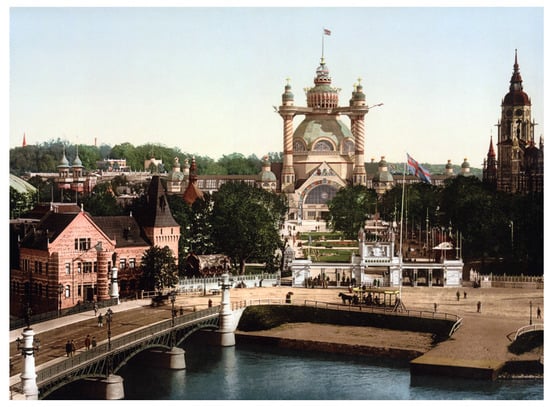
Figure 2.
Allmänna konst- och industriutställningen 1897 (The General Art and Industry Exhibition 1897) in Stockholm. In the centre of the photo is the Great Exhibition Hall by Ferdinand Boberg (1860–1946) and Fredrik Lilljekvist (1863–1932). Hand-coloured photochrome, Detroit Publishing Co., United States Library of Congress, Public Domain.
In her essay “Om patriotism” Ellen Key has surprisingly kind words to say regarding the exhibition—given her striving for cultural renewal. She refers less to the art and architecture of the exposition—apart from praising the work of her friend Carl Larsson, who through this occasion would gain access to a wide audience—and more to the exhibition as an expression of national pride, energy, creativity and, as she wrote, as “a great national event”, through which “national enthusiasm and national self-confidence experienced a renaissance”. In so doing she concedes that this newly won self-consciousness was less the result of a national orientation of art, handcrafts or architecture but of the success of science, technology and industry (Key 1897a, pp. 246–47; cf. Häfner 1998, pp. 42–47).
The reversion to traditional folk crafts and the distancing of Arts and Crafts from industrial production was not least thanks to external stimuli. In addition to the National Romantic movement in Norway, mention could also be made of the Austro-German art historian Jacob von Falke (1825–1897), director of the Liechtenstein Gemäldegalerie in Vienna and later of the Austrian Museum of Applied Arts. He visited Sweden in 1870 on the invitation of King Carl XV (1826–1872, regnavit 1859–1872), and in his book, Die Kunst im Hause (“Art in the Home”), published the following year, and translated into both Swedish and Norwegian, he expresses his admiration for Scandinavian Arts and Crafts. The English Arts and Crafts movement, the rise of which was followed with keen interest in Sweden, was another important influence. Ellen Key—as well as Carl Larsson—was influenced by publications from the movement. She was a reader, for example, of the Arts and Crafts periodical The Studio, from the beginning of its official publication in 1893, from 1894 onwards of the writings of John Ruskin (1819–1900) and from 1895 onwards of those of William Morris (1834–1896) as well. She later makes numerous references to them in her own writings, especially in Beauty for Everyone (Sheffield 1997, pp. 35–37; cf. Lane 2008, pp. 22–23).
2.3. Beauty for Everyone
Ellen Key did not only spread her conception of an artistic enrichment of everyday life through her writings and lectures. In the spring and autumn of 1899, as the first step towards reform of Arts and Crafts and cultural renewal, together with three friends from the Junta Society, Gerda and Richard Bergh and Carl G. Laurin, she furnished two model rooms in the Stockholm Workers’ Institute, the so-called Blue and Green Rooms. The furnishings were to demonstrate “simple and functional forms” and were a “mixture of rural Swedish and contemporary English” styles (Key 1900b, pp. 40–42). The furniture was designed by Carl Westman, the crockery by the artist Alf Wallander (1862–1914). The facilities were completed with reproductions of artworks on the walls: in the Blue Room, for instance, through pictures by artists as varied as Albrecht Dürer (1471–1528), Jean-François Millet (1814–1875) and Carl Larsson, painters whom Key and her co-campaigners clearly regarded as models (in the case of Dürer and Millet), or as part of the Nordic life reform movement, and were intended to add artistic support to the pedagogical import of the interior. The model rooms were to demonstrate how, through the use of functional furniture, the contribution of harmonious colours and the rejection of historical décor, interiors could be furnished tastefully and with little expense (Key 1900b; cf. Lengborn 2002, pp. 69–75; Lane 2008, p. 24).
The great success of this exhibition—it was viewed by 5.000 visitors—encouraged Ellen Key to extend and revise her essay “Skönhet i hemmen” (“Beauty in the Home”) published in 1897. Together with the three magazine articles published in 1891–1897: “Vardagsskönhet” (“Everyday Beauty”), “Festvanor” (“Festive Customs”) and “Skymningsbrasan” (“The Twilight Fire”) she presents a summary in the anthology Skönhet för Alla (“Beauty for Everyone”) (Key 1891, 1895, 1896, 1897b). This appeared in 1899 with a title page designed by Carl Larsson in the series of the radical Uppsala Student Association Verdandi published by her friend Albert Bonnier ((Key 1899); Figure 3).
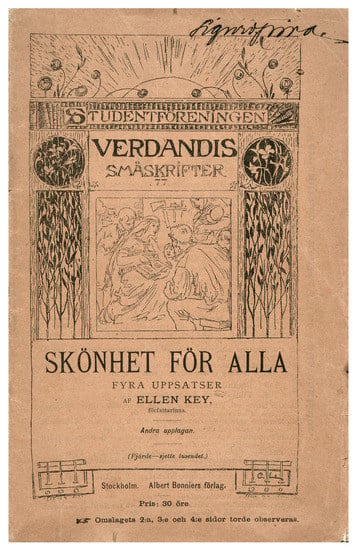
Figure 3.
Ellen Key (1849–1926): Skönhet för Alla (“Beauty for Everyone”), Stockholm 1899. Cover by Carl Larsson (1853–1919).
In these four essays, Ellen Key sets out a comprehensive agenda for cultural renewal, ranging from the reform of Arts and Crafts through the artistic enrichment of daily life to the establishment of festive customs—in short aimed at a “religion of beauty”. In the essay “Beauty in the Home”, Ellen Key begins, by referring to the conclusion of the Swedish art theorist of the late 18th century Carl August Ehrensvärd (1745–1800), that the need for beauty is a fundamental human need. From this, she develops a practical guide for home furnishings, propagating maxims like simplicity, practicality and expression of individual taste. She especially criticizes the “shabby German” taste of the 1870s to 1890s, i.e., the industrially manufactured ruffles and plush interiors of late Historicism. In opposition to this, she proposes an artistically sophisticated “everyday aesthetics” (“vardagslivets estetik”), arising on the one hand from the Gustavian classicism, whose combination of respectable austerity and simplicity expresses moral as well as aesthetic quality, and on the other hand, the Arts and Crafts of traditional rural folk culture. Ellen Key envisages the path to this Beauty for Everyone, among other things, to be through the co-operation of industry and crafts, as she wrote in “Beauty in the Home”:
“The only possibility of having more tasteful urban rooms is to begin by demanding from all sides that they are not decked out with these ugly and senseless frills but instead simplified in the direction of sound and refined taste. And the only way to ensure that everyone can acquire really affordable and lovely things is that the manufacturers—in particular of furniture, wallpaper, fabrics, glass, porcelain and metal objects—link up with Arts and Crafts practitioners so that all of these objects, from the simplest and smallest, such as the match box, to the largest, are given a beautiful form and appropriate decoration. Only then, when there is nothing ugly left to buy, when beautiful things are as cheap as ugly ones now are, can beauty for everyone actually become a reality.”((Key 1899), quoted here in (Key 1913, pp. 5–6).)
In this context Ellen Key refers repeatedly to John Ruskin and, at least in the revised version of 1899, to William Morris as well. Their influence characterizes especially the aesthetic ideals that she formulates in Beauty for Everyone. She traces the roots of beauty to functionality, the sense of beauty to moderation and restraint and good taste to honesty. The ideal of beautiful Arts and Crafts products correspondingly derives from functional form, the absence of ornament, and good materials (Key 1899, pp. 11, 18, 21). As part of an aesthetic education and to become acquainted with the traditional rural folk culture, Ellen Key recommends a visit to the open-air museum Skansen, founded in 1891 on the Stockholm island Djurgården. And as a model of the ideal of festively refined, everyday aesthetics, she proposes the artistically conceived and handicraft-rich home of Carl and Karin Larsson, Lilla Hyttnäs in Sundborn, which they had furnished with simple, colourful, furniture and textiles inspired by traditional rural models (Key 1897b, pp. 15–17; cf. Häfner 1998, pp. 31–35; Lane 2008, pp. 25–27).
In her essay “Everyday Beauty”, the reformer evokes the beauty of the unadorned everyday life in nature’s change of the seasons—meaning life in the country—the joy of simple work and self-realisation in art. In this context, she proposes a series of life principles, such as that every day you should read a good book. Here it is most apparent that not only arts and crafts and painting, but also education, through regular reading, plays a central role in the life reform movement, and, together with the joy of the simple life, comprises the celebration of everyday life, the “Beauty of Everyday Life” (Key 1891; cf. Sheffield 1997, p. 39).
In “Festive Customs”, Ellen Key laments the loss of old customs and holidays—and attributes this to a lack of healthy conservatism. She calls for a renewal of the holiday calendar to promote the establishment of traditions continuing through generations and the festive elevation of everyday life. She sketches out a festive calendar which includes both Christian high days and popular folk customs, such as Christmas, New Year’s, Twelfth Night, Easter, Spring and Midsummer festivals, and describes the relevant festive rituals for each of them. She conceives of these celebrations less as a precursor to a golden age in the sense of Nietzsche, but first and foremost as a life-reform means to structure and elevate everyday life. In this context, she also notes that such festive occasions are more significant for children and that it is the task of the mother as “the artist of the domestic sphere”, to communicate to her children, for instance through festive occasions, a sense of beauty—a theme which she would later deal with in more detail in The Century of the Child (Key 1896, 1900a; cf. Sheffield 1997, pp. 39–40).
Finally, in “The Twilight Fire”, the most poetic and overtly nationalistic of the four texts, Ellen Key highlights the importance of light, twilight and fire in the long, dark winters and bright summers as the origin of many Nordic traditions. She focuses on the central role of the hearth in Nordic life and myth. It not only provides warmth and illuminates the darkness, but it also serves as a social center of the home and in a figurative sense it even becomes a metaphor for creativity (Key 1895; cf. Sheffield 1997, p. 40).
Ellen Key’s Beauty for Everyone is therefore based on a combination of the reformed Arts and Crafts, proximity to nature, down-to-earth work, artistic and literary education, as well as inter-generational traditions in the form of a festive customs. These aspects are manifested not only in Ellen Key’s show rooms and publications, but also in contemporary Nordic painting.
3. Nordic Painting in the Second Half of the 19th Century
3.1. Between the Centre and the Periphery
In tandem with efforts to develop a new everyday culture and to reform Arts and Crafts, Nordic painters discovered the “Nordic” as a subject together with motives closely related to it, such as the artists’ celebration and the festive ritual. This happened primarily through views from the outside, i.e., by painters who had escaped the narrow circumstances of their home-countries—the art academies in Denmark and Sweden or the private schools in Norway and Finland. At the beginning of the 19th century, the framework of academic training still mainly encompassed a Grand Tour to Italy, although the academies in Munich and particularly in Düsseldorf, beginning around 1840, gained in attractiveness. In the 1860s, and at the latest with the Franco-Prussian War of 1870–1871, these centres in turn declined in popularity, and Paris became, as the cultural mecca of Europe, the preferred destination of Nordic painters (Varnedoe 1982, pp. 13–19; Hedström 2012, pp. 187–90).
In the 1870s and 1880s, a veritable colony of Nordic artists arose in the French capital, studying mainly in private academies or taking lessons in the studios of established painters. For example, the previously mentioned Hanna Pauli attended the Académie Colarossi in 1885–1887. Among the private teachers, Léon Bonnat (1833–1922) was the most popular. His Nordic students included, for example, in 1877–1879 the Dane P.S. (Peder Severin) Krøyer (1851–1909), in 1885 the Norwegian Edvard Munch (1863–1944), and in 1887–1889 Prince Eugen of Sweden (1865–1947) (Sarajas-Korte 1982). Among the Nordic painters living in Paris at this time are some of those who achieved great success and became known internationally—first and foremost the Suedo-Finnish Albert Edelfelt (1854–1905), as well as the somewhat younger Anders Zorn. After studying in Stockholm and undertaking extensive study trips, Anders Zorn moved to Paris in 1888 and remained there—with the exception of a one-year stay in the United States on the occasion of the World’s Columbian Exposition in Chicago 1893—for eight years. He became one of the most prominent painters in the French capital, before returning to Stockholm in 1896 (Bastek 2012).
In Paris, the Nordic painters encountered the latest cultural currents and artistic techniques of the time, such as realism, naturalism and impressionism, and, in the artist colonies in Barbizon and Grez-sur-Loing, the practice of painting en plein air. Furthermore, they discovered a broad range of new artistic subjects. It is striking that they only developed a limited interest in portraying the bustle of city life, although their cosmopolitan experience and the cultural life in the French capital, with its ateliers, salons and cafés, must have served not only as the backdrop for their creation, but also as an influential source of inspiration for the painters from the countries on the northern periphery of Europe. However, their esteem for their native lands, more precisely the penchant for the representation of the Nordic landscape and rural life grew; things Nordic became a much-loved topos. This enthusiasm found support from abroad in the generally pessimistic and anti-modern mood, which was widespread in the Panic of 1873 and the Long Depression (1873–1896) on the European continent, following which especially Norway and Finland were reinterpreted and transformed from a backward periphery to the image of unspoiled origins (Varnedoe 1982, pp. 13–19; Huusko 2012). This explains the growing appreciation which the Nordic painters enjoyed. If they were still little appreciated at the Exposition universelle de Paris de 1878 (World Exhibition of 1878 in Paris), the French critics at the Exposition universelle de Paris de 1889 (World Exhibition of 1889 in Paris) showed they were sufficiently impressed to maintain that they had not only caught up with French painters technically but their work also showed that unique “Nordic” quality (Braun 1982).
3.2. Artists’ Celebrations and Festive Rituals as Motifs
Two visual themes stand out alongside the representations of landscapes together with impressions of light and weather—“Twilight and Light” (Jackson and Lange 2012)—as especially typical for Nordic painting: the artists’ celebration and the rural holiday customs. Both subjects take on major significance in the Nordic life reform movement and complement or partially overlap with Ellen Key’s concepts of “Festive Customs” and “Everyday Beauty”.
Among the Nordic painters, the theme of artists gathering for a festive ritual became a systematic self-representation of a group which regarded itself primarily as a cultural trend-setter in post-feudal society. This can be seen in two examples of works featuring this subject: Hugo Birger’s (1854–1887) “Skandinaviska konstnärernas frukost i Café Ledoyen” (“Scandinavian artists at Breakfast in Café Ledoyen”) depicting a number of Scandinavian artists at breakfast in Café Ledoyen in Paris on the day of the Paris Salon’s opening in 1886, and P.S. Krøyer’s “Hip, hip, hurra! Kunstnerfest på Skagen” (“Hip, hip, hooray! Artists’ Celebration in Skagen”, 1884–1888) (Figure 4 and Figure 5). Despite the festive informality of the image and the spontaneity they portray, both pictures are consciously composed illustrations of the two groups of artists, the leading Swedish and Finnish artists in Paris in 1886, and the members of the artists’ colony in the Danish Skagen district. In both pictures it is possible to read not only the composition of the respective group at the time—each person represented was and still is known by name—but also of the relations between those portrayed. In addition, both portray the artists as established bourgeois groups. For example, Hugo Birger placed them on the opening day of the Paris Salon in a highly representative locale, i.e., the Café Ledoyen, one of the finest establishments in the French capital, between the Avenue des Champs-Élysées and the River Seine, at that time situated behind the Palais de l’Industrie (erected in 1855, demolished in 1897) and today located behind the Petit Palais, built in 1897–1900 (Arvidsson et al. 2014, pp. 150–53, 164–67).
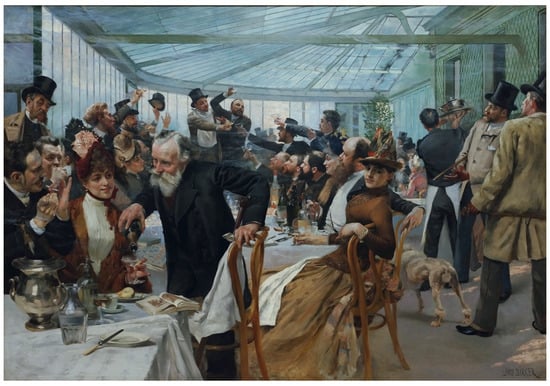
Figure 4.
Hugo Birger (1854–1887): Skandinaviska konstnärernas frukost i Café Ledoyen, Paris fernissadagen 1886 (“Scandinavian Artists at Breakfast in Café Ledoyen on the day of the Paris Salon’s opening in 1886”), 1886, oil on canvas, 183.5 cm × 261.5 cm, Göteborgs Konstmuseum, Public domain.
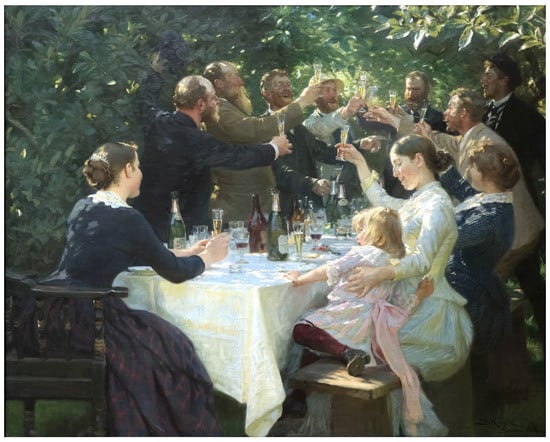
Figure 5.
P.S. [Peder Severin] Krøyer (1851–1909): Hip, hip, hurra! Kunstnerfest på Skagen (“Hip, hip, hooray! Artists’ Celebration in Skagen”), 1884–1888, oil on canvas, 134.5 cm × 165.5 cm, Göteborgs Konstmuseum, Public domain.
The motif depicting rural holiday customs appeared, and grew in importance, in response to the national romantic criticism of what was deemed to be the vulgar urban mass culture of the industrial age, coupled with what was seen as an obsolete monarchist national rhetoric. The farming class was regarded as the cradle of Nordic society and the preservation and artistic representation of traditional rural festive customs was seen as a contribution to cultural renewal. This renewal, however, had not only progressive but also conservative, even restorative features. To this it must be added that rural customs and traditions in the late 19th century in the Nordic countries, just as in the countries of the European continent, were on the retreat—as a result of rural depopulation, urbanization and industrialization (Häfner 1998, pp. 25–31; cf. Lane 2000, pp. 19–48).
A special importance was placed in the Nordic countries on Midsummer celebration (“Midsommar”), at summer solstice. It was viewed by rural people often as the year’s second-most important celebration, after Christmas. Although its roots date back to pre-Christian traditions, the Midsummer celebration—just like celebration of St. Lucia’s day and many other modern holidays—only acquired its current form and became universally significant for the whole country in the late 19th century. This was partly the result of conscious efforts to construct a new national tradition (Frykman and Löfgren 1991). The great importance of the midsummer for creating a national identity can be explained by its combination of popular tradition and natural display: On the one hand it is a festival linked to a number of popular folk customs, such as dancing around the Midsummer Pole (“midsommarstång”) or May Pole, as portrayed in Anders Zorn’s famous “Midsommardans” (“Midsummer Dance”, 1897) (Figure 6). On the other hand, summer solstice, as the longest day of the year, is actually a day without night in the northern parts of Scandinavia. Through its annual recurrence, it not only serves as the basis for the ritual character of the festival, but also connects it with a cosmic or atavistic natural experience, the idea of a soulful nature. In both art and literature this is often continued in the parallel linking of inner psychological and external natural experience (Varnedoe 1982, pp. 18–19).
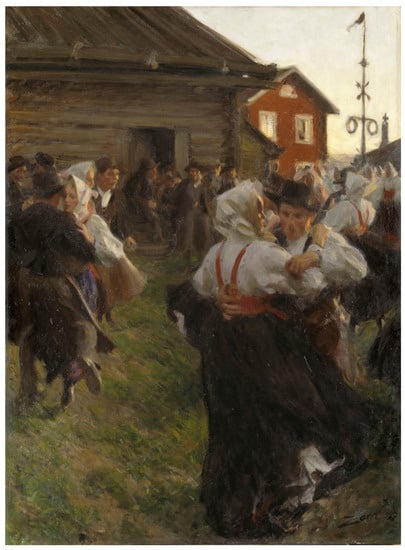
Figure 6.
Anders Zorn (1860–1920): Midsommardans (“Midsummer Dance”), 1897, oil on canvas, 140 cm × 98 cm, Nationalmuseum Stockholm, Public domain.
The two topics of artists’ celebrations and festive rituals acquire a great significance in the artist colonies and groups which the Nordic artists established, first in France, and later in the Nordic countries, as a programmatic, ideal image of their own life in these colonies and groups, and in turn, as an expression of the life reform quest for cultural renewal. Carl Larsson, who lived in Paris from 1877, spent the summers of 1880 and 1881 in Barbizon and the years 1882–1885 in nearby Grez-sur-Loing—both artists’ colonies to the south of Paris in the district of Fontainebleau. In Grez-sur-Loing he met his wife, the Swedish painter Karin Bergöö, and there he discovered watercolour painting. Some of his most important works were painted there (Lofgren 1992). During these years quite a few Nordic artists moved to Grez-sur-Loing, including among others P.S. Krøyer and Richard Bergh (Herlitz 2013). They would provide important impulses for the subsequent establishment of several artists’ colonies and groups in the Nordic countries, e.g., through P.S. Krøyer on the Skagen painters in Denmark (Svanholm 2004), Richard Bergh and Carl Larsson on “The Opponents” in Stockholm, and Richard Bergh on the so-called “Varberg school”. In this context, mention must also be made of the Swedish author August Strindberg (1849–1912), who stayed in Grez-sur-Loing and later in Paris in 1882, and returned to the French capital in the years 1885–1887 and in 1894. In the 1870s Strindberg had already written on impressionist painting, and from his time in France came a travel report, Bland franska bönder (“Among French farmers”, 1889), as well as the autobiographical novels Inferno and Legender (“Inferno”, 1897, “Legends”, 1898). Not only do these works provide an insight into Strindberg’s experiences during his time in Grez-sur-Loing and Paris, but also spotlight the country life and the art scene there (Brandell 1983; Hedström 2012, p. 194; cf. Herlitz 2013, p. 242).
4. A Synthesis of a Literary, Artistic and Arts and Crafts Renewal Movement
4.1. A Home: Life Reform as Lived and Promoted by Carl Larsson
In the last decade of the 19th century a number of Nordic painters returned to their native countries from abroad. For example, Carl and Karin Larsson moved to Sundborn and Anders Zorn to Mora—both in the Dales (Dalarna) region—and the previously mentioned artist colonies and groups developed. This shifted the discourse on cultural renewal to those locations. To an increasing extent, the various Arts and Crafts, artistic and literary renewal movements united in a synthesis; this applied in particular to Ellen Key’s ideas of “Everyday Beauty” and “Festive Customs” and the painters’ characteristic “Nordic” subjects of artists’ celebrations and festive rituals. They merged with the broader life reform movement of renewal which drove social and cultural renewal—in both Arts and Crafts and in architecture (Lane 2000, pp. 79–117).
Carl Larsson’s work and way of life serves as an exemplary embodiment of this life reformist renewal. At its core was a synthesis of art and life, as well as the ideal of a cheerful life in the country, unspoiled by modern industry. Carl Larsson’s paintings show primarily the life of his own family in their home Lilla Hyttnäs, designed by him together with his wife Karin. He explained that his pictures were less naturalistic representations, but more a “manifesto”, aimed at reforming equally “taste and family life” (Larsson 1899, p. 48). In fact, the domestic life and the everyday pursuits of the couple and their eight children were artistically enhanced. This became, as Ellen Key wrote, the product of “ingenious inspiration, festive moments and joyful work” (Key 1897b, pp. 15–17, here p. 17). They worked and played and Carl Larsson presented a series of holiday customs which structured and enriched the family’s everyday life, shown in the picture “Namnsdag på härbret” (“Nameday in the Storage House”, 1898; (Larsson 1899)) (Figure 7).
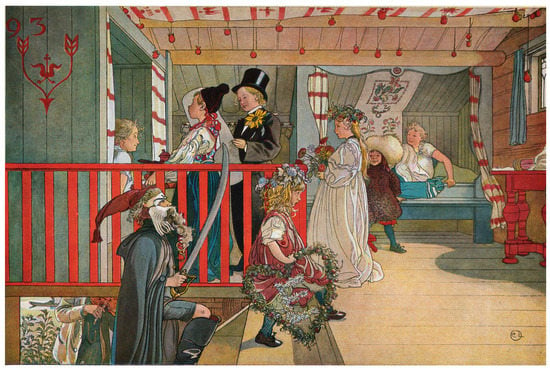
Figure 7.
Carl Larsson (1853–1919): Namnsdag på härbret (“Nameday in the Storage House”), watercolour, ca. 1895, watercolour, 32 cm × 43 cm, Nationalmuseum Stockholm, Public domain.
Carl Larsson’s works spread widely through his numerous books, such as Ett hem (“A Home”, (Larsson 1899)), Spadarfvet, mitt lilla landtbruk (“In the Country with Us”, (Larsson 1906)) or Åt solsidan (“On the Sunny Side”, (Larsson 1910)) (Figure 8). They served as visual illustrations for the writings of Ellen Key, who herself referred repeatedly to her friend Larsson. Together they founded the much-touted “Swedish style”—that is based on aforementioned artistically refined “everyday aesthetics” and that draws both on traditional folk handcrafts as well as the ideas of Arts and Crafts and life reform movements. It became a greatly admired and imitated model, not only in its country of origin but also world-wide (Snodin and Stavenow-Hidemark 1997; Lengefeld 1993).
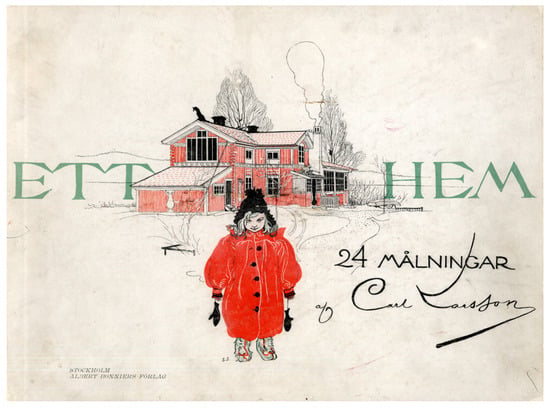
Figure 8.
Carl Larsson (1853–1919): Ett hem (“A Home”), Stockholm, Albert Bonniers Forlag, 1899, cover.
In Sweden Ragnar Östberg (1866–1945), one of the country’s leading architects, was among those to take up the ideas of Ellen Key and Carl Larsson. In 1906 he published his own booklet with the title Ett Hem (“A Home”), an introduction to the building and furnishing of artistically designed country cottages (Östberg 1906; cf. Sheffield 1997, pp. 41–43) (Figure 9). They also influenced, for instance, the Skønvirke movement in Denmark, which arose at the beginning of the 20th century around Caspar Leuning Borch (1853–1910), Anton Rosen (1859–1928) and P.V. [Peder Vilhelm] Jensen Klint (1853–1930), which was situated between Art Nouveau and National Romanticism and became institutionalised in 1914 with the publication of a periodical with the same title. Finally, Ellen Key and Carl Larsson communicated extensively with the national romantic circle of the polar explorer Fridtjof Nansen (1861–1930), the painter Gerhard Munthe (1849–1929) and the young architect Arnstein Arneberg (1882–1961) in Lysaker in Norway (Lane 2000, pp. 79–89).
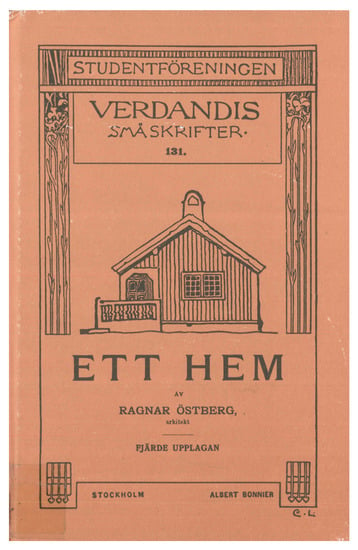
Figure 9.
Ragnar Östberg (1866–1945): Ett Hem (“A Home”), Stockholm, Albert Bonniers Förlag, 1906, cover.
4.2. From Home to Actually Existing “People’s Home”
The efforts of Ellen Key and Carl Larsson were also reflected in Swedish Arts and Crafts, as can be seen in contemporary Arts and Crafts exhibitions, and later in the work of the art historian Gregor Paulsson (1889–1977). For instance, the exhibition Konstindustriutställningen 1909 (Arts and Crafts Exposition 1909) strongly reflected a return to indigenous handcrafts and artwork. In keeping with the life reform ideas, from its buildings to the entrance tickets, the exhibition was completely designed in a bright romantic style by Ferdinand Boberg (Sörenson 1999, pp. 357–420).
Gregor Paulsson, from 1920 onwards director of the Swedish Arts and Crafts Association and a key figure in the modernisation of architecture and Arts and Crafts, makes frequent reference to Ellen Key (Sheffield 1997, pp. 43–49). As he writes in his autobiography, his reading of Ellen Key’s Folkbildningsarbetet (“Popular education”, (Key 1906)) is a transformational educational experience (Paulsson 1974, p. 14). Both his books Den nya arkitekturen (“The New Architecture”, (Paulsson 1916)) and Vackrare vardagsvara (“Better Things for Everyday Life”, (Paulsson 1919)) are to a certain extent a continuation of Ellen Key’s efforts—although he primarily bases them on the ideas of the German Werkbund and the German debate prior to World War I (Seelow 2016a). He calls for an extensive reform of Swedish Arts and Crafts and describes a concept of developing taste through artistic education (Paulsson 1916; Paulsson 1919). Similarly, Hemutställningen (Home Exhibition), which he curated in Liljevalchs Konsthall (1917), at which 23 furnished affordable apartments for plain workers were on display, could be regarded as a continuation of Ellen Key’s Blue and Green Rooms (Wickman 1995).
The same applies to Stockholmsutställningen 1930 av konstindustri, konsthantverk och hemslöjd (Stockholm Exhibition 1930 of Art and Crafts and Home Industries) directed by Gregor Paulsson. Together with the Acceptera manifesto published by the exhibitors in 1931, it marks the breakthrough of Modernism in Sweden and the Nordic countries (Asplund et al. 1931; Rudberg 1999; Seelow 2016b). The Modernism featured in the exhibition and promoted in the Acceptera manifesto under the keyword “Functionalism”, in architecture, urban planning and arts and crafts is regarded not only as the product of an inevitable progress, which has to be “accepted”—hence the title Acceptera—but also as a logical continuation of traditional architecture and arts and crafts following Ellen Key’s “Everyday Beauty” (cf. Näsström 1930).
In subsequent years, this functionalism developed into an agenda equally aesthetic and political for the restructuring of Sweden as a “Folkhem” (literally “a People’s Home”), the term symbolising Sweden’s social democratic welfare state (Lund 1998; Rudberg 1998). Under the social democratic prime minister Per Albin Hansson (1885–1946), Ellen Key’s concept of home, supported by the concept of “Samhällsmoderlighet” (“society’s motherly care”), which she proposed and which included state welfare and state relief, was expanded to a meaningful model for the social community life of the entire society (Key 1903; cf. Rudberg 1992).
5. Conclusions
The life reformist renewal movement, which arose in the Nordic countries as a response to the crisis resulting from industrialisation, extended far beyond the reform of individual spheres of life. On the contrary, from the demand for social and cultural renewal a comprehensive agenda grew for reform of the national culture. This ranged from reform of the Arts and Crafts, with a revival of traditional folk handcrafts, through the discovery of the “Nordic” as a subject for painting, to the artistic elevation of everyday life and the establishment of festive rituals.
The concepts of “Festive Customs” and “Everyday Beauty” promoted by Ellen Key played a decisive role, as they provided the programmatic basis for a festive enrichment of everyday life as well as applying an aesthetic assessment to all its aspects. Ellen Key called for a new “religion of beauty” which, based on the beauty of the home, would conquer arts and crafts, architecture and everyday life, elevate everyday living and ultimately transform the society. It is worth noting in this context the extent to which the two notions of “Festive Customs” and “Everyday Beauty” served to encompass the various reform efforts and as such contributed to overcoming the boundaries between the different media—painting, arts and crafts, and architecture. The ideas expressed by Ellen Key in her writings on “Festive Customs” and “Everyday Beauty”—summarized in Beauty for Everyone—found their expression in painting as well as in arts and crafts, and architecture.
Thanks to the complementary effects and mutual enhancement of the various media, the Nordic life reform movement succeeded in linking its quest for cultural and social renewal to a comprehensive festive ennobling of everyday life and an artistically enhanced everyday beauty. Conversely, it can be stated that through the parallel impact of efforts in the various media they become themselves a festival of everyday life, to some extent the boundaries between agenda and self-presentation or even between art and life were dissolved. This can be observed most clearly in the life and work of Carl Larsson. During his stay in Paris and Grez-sur-Loing, and later with his membership of groups such as The Opponents or the Junta Society, and through his exchanges with Ellen Key he became one of the leading protagonists of the Nordic life reform movement. His pictures show the results of these efforts in the example of his own family—the life characterised by festivities in their artistically furnished home. Finally, Carl Larsson’s life and work was further promoted in numerous publications, both his own as well as those of Ellen Key, as a perfect example of the vaunted life reform ideals.
In its pursuit of national and cultural renewal the Nordic life reform movement was not only successful in permanently influencing painting, arts and crafts and architecture, but to a certain extent in spreading the renewal to the whole of society—unlike the Arts and Crafts or life reform movements in many other countries. Admittedly this did not result in a golden age or “total festivity”. But the renewal contributed in Sweden also to transforming the country, through a conversion equally aesthetic as well as political, to a “People’s Home” version of a social democratic welfare state.
Conflicts of Interest
The author declares no conflict of interest.
References
- Ambjörnsson, Ronny. 2012. Ellen Key. En Europeisk Intellektuell. Stockholm: Albert Bonniers Förlag, ISBN 9789100113490. [Google Scholar]
- Arvidsson, Kristoffer, Per Dahlström, and Anna Hyltze. 2014. The Collection. Gothenburg Museum of Art. Gothenburg: Göteborgs Konstmuseum, ISBN 9789187968891. [Google Scholar]
- Asplund, Gunnar, Wolter Gahn, Sven Markelius, Gregor Paulsson, Eskil Sundahl, and Uno Åhrén. 1931. Acceptera. Stockholm: Tiden, Reprint 1981 edited by Anders Åman. Stockholm: Tidens Förlag. ISBN 9155023886. English translation 2008 in Modern Swedish Design. Three Founding Texts. Edited by Lucy Creagh, Helena Kåberg and Barbara Miller Lane. New York: The Museum of Modern Art. pp. 140–347. ISBN 9780870707223. [Google Scholar]
- Assmann, Aleida. 1989. Festen und Fasten. Zur Kulturgeschichte und Krise des bürgerlichen Festes. In Das Fest. Edited by Walter Haug and Rainer Warning. Munich: Wilhelm Fink Verlag, pp. 227–46. ISBN 3770525779. [Google Scholar]
- Bastek, Alexander. 2012. Anders Zorn. Der Schwedische Impressionist. Petersberg: Michael Imhof Verlag, ISBN 9783865687418. [Google Scholar]
- Berggren, Henrik. 1995. Seklets Ungdom. Retorik, Politik och Modernitet 1900–1939. Stockholm: Tiden, ISBN 9155042465. [Google Scholar]
- Brandell, Gunnar. 1983. Strindberg. Ett Författarliv III. Paris, Till Och Från 1894–1898. Stockholm: Alba, ISBN 9174585657. [Google Scholar]
- Braun, Emily. 1982. Scandinavian Painting and the French Critics. In Northern Light. Realism and Symbolism in Scandinavian Painting 1880–1910. Edited by Kirk Varnedoe. Brooklyn: The Brooklyn Museum, pp. 67–75. ISBN 0300041462. [Google Scholar]
- Ekström, Anders. 1994. Den Utställda Världen. Stockholmsutställningen 1897 och 1800-Talets Världsutställningar. Stockholm: Nordiska Museet, ISBN 9171083707. [Google Scholar]
- Frick, Gunilla. 1978. Svenska Slöjdföreningen och Kunstindustrin Före 1905. Stockholm: Nordiska museet, ISBN 9171081488. [Google Scholar]
- Friedman, Alice T. 2002. Frank Lloyd Wright and Feminism. Mamah Borthwick’s Letters to Ellen Key. Journal of the Society of Architectural Historians 2: 140–51. [Google Scholar] [CrossRef]
- Frykman, Jonas, and Orvar Löfgren. 1991. Svenska Vanor Och Ovanor. Stockholm: Natur och kultur, ISBN 9127027554. [Google Scholar]
- Häfner, Gabriela. 1998. Ellen Key und Das Kulturelle Selbstverständnis Schwedens Zwischen Tradition und Moderne. Berlin: Humboldt-Universität zu Berlin, ISBN 3932406192. [Google Scholar]
- Hasselgren, Andreas. 1897. Utställningen i Stockholm 1897. Beskrifning i Ord och Bild Öfver Almänna Konst & Industriutställningen. Stockholm: Fröléen. [Google Scholar]
- Hedström, Per. 2012. International oder national? Nordische Maler und Europa. In Aus Dämmerung und Licht. Meisterwerke Nordischer Malerei 1860–1920. Edited by David Jackson and Christiane Lange. Munich: Hirmer Verlag, pp. 187–95. ISBN 9783777457116. [Google Scholar]
- Heidenstam, Verner von. 1896. Om svenskarnes lynne. Ord & Bild 5: 1–11, Reprint 1995 in Svenska Krusbär. En Historiebok om Sverige och Svenskar. Edited by Björn Linnell and Mikael Löfgren. Stockholm: Bonnier Alba, pp. 224–38. ISBN 9134517669. [Google Scholar]
- Henningsen, Bernd, Janine Klein, Helmut Müssener, and Solfrid Söderlind. 1997. Wahlverwandtschaft. Skandinavien und Deutschland 1800 bis 1914. Berlin: Deutsches Historisches Museum, Nationalmuseum and Norsk Folkemuseum, ISBN 3931321606. [Google Scholar]
- Herlitz, Alexandra. 2013. Grez-Sur-Loing Revisited. The International Artists’ Colony in a Different Light. Gothenburg and Stockholm: Makadam, ISBN 9789170611391. [Google Scholar]
- Huusko, Timo. 2012. Kunst und nationale Künstlerschaft in den Nordischen Ländern. In Aus Dämmerung und Licht. Meisterwerke Nordischer Malerei 1860–1920. Edited by David Jackson and Christiane Lange. Munich: Hirmer Verlag, pp. 197–205. ISBN 9783777457116. [Google Scholar]
- Jackson, David, and Christiane Lange. 2012. Aus Dämmerung und Licht. Meisterwerke nordischer Malerei 1860–1920. Munich: Hirmer, ISBN 9783777457116. [Google Scholar]
- Key, Ellen. 1891. Vardagsskönhet. In Julbloss. Reprint in Ellen Key 1899. Skönhet för Alla, 5th ed. 1913. Stockholm: Albert Bonniers Förlag, pp. 37–42. [Google Scholar]
- Key, Ellen. 1895. Skymningsbrasan. Reprint in Ellen Key 1899. Skönhet för Alla, 5th ed. 1913. Stockholm: Albert Bonniers Förlag, pp. 47–53. [Google Scholar]
- Key, Ellen. 1896. Festvanor. In Idun. Reprint in Ellen Key 1899. Skönhet för Alla, 5th ed. 1913. Stockholm: Albert Bonniers Förlag, pp. 42–47. [Google Scholar]
- Key, Ellen. 1897a. Om patriotism. Öppet brev till min vän Verner von Heidenstam. In Vintergatan. Reprint 1995 in Svenska krusbär. En Historiebok om Sverige och Svenskar. Edited by Björn Linnell and Mikael Löfgren. Stockholm: Bonnier Alba, pp. 239–65. ISBN 9134517669. [Google Scholar]
- Key, Ellen. 1897b. Skönhet i hemmen. In Idun. Reprint in Ellen Key. 1899. Skönhet för Alla, 5th ed. 1913. Stockholm: Albert Bonniers Förlag, pp. 3–37. English translation 2008 in Modern Swedish Design. Three Founding Texts. Edited by Lucy Creagh, Helena Kåberg and Barbara Miller Lane. New York: The Museum of Modern Art, pp. 32–57. ISBN 9780870707223. [Google Scholar]
- Key, Ellen. 1899. Skönhet för Alla, 5th ed. 1913. Stockholm: Albert Bonniers Förlag. [Google Scholar]
- Key, Ellen. 1900a. Barnets Århundrade. Stockholm: Albert Bonniers Förlag. [Google Scholar]
- Key, Ellen. 1900b. Folket och konsten. Varia. Illustrerad Månadstidskrift 1: 34–44. [Google Scholar]
- Key, Ellen. 1903. Samhällsmoderlighet. In Ellen Key. In Lifslinjer I. Stockholm 1903. Reprint in Ronny Ambjörnsson. 1976. Ellen Key. Hemmets Århundrade. Stockholm: Aldus, pp. 156–85. ISBN 9100409960. [Google Scholar]
- Key, Ellen. 1906. Folkbildningsarbetet. Särskildt med Hänsyn till Skönhetssinnets Odling. Uppsala: Appelbergs Boktryckeri. [Google Scholar]
- Lane, Barbara Miller. 2000. National Romanticism and Modern Architecture in Germany and the Scandinavian Countries. Cambridge: Cambridge University Press, ISBN 0521583098. [Google Scholar]
- Lane, Barbara Miller. 2008 An Introduction to Ellen Key’s “Beauty in the Home”. In Modern Swedish Design. Three Founding Texts. Edited by Lucy Creagh, Helena Kåberg and Barbara Miller Lane. New York: The Museum of Modern Art, pp. 19–31. ISBN 9780870707223.
- Larsson, Carl. 1899. Ett hem. Stockholm: Albert Bonniers Förlag. [Google Scholar]
- Larsson, Carl. 1906. Spadarfvet, Mitt Lilla Landtbruk. Stockholm: Albert Bonniers Förlag. [Google Scholar]
- Larsson, Carl. 1910. Åt Solsidan. Stockholm: Albert Bonniers Förlag. [Google Scholar]
- Lengborn, Thorbjörn. 2002. Ellen Key Och Skönheten. Estetiska och Konstpedagogiska Utvecklingslinjer i Ellen Keys Författarskap 1891–1906. Hedemora: Gidlund, ISBN 9178443482. [Google Scholar]
- Lengefeld, Cecilia. 1993. Der Maler des Glücklichen Heims. Zur Rezeption Carl Larssons im Wilhelminischen Deutschland. Heidelberg: Universitätsverlag C. Winter, ISBN 3825301052. [Google Scholar]
- Lofgren, John Z. 1992. Carl Larsson. The Autobiography of Sweden’s Most Beloved Artist. Iowa City: Penfield Press, ISBN 0941016919. [Google Scholar]
- Lund, Nils-Ole. 1998. Modernism as a vehicle for social change in the Nordic welfare-states. In Modern Movement Scandinavia. Vision and Reality. Edited by Ola Wedebrunn. Kopenhagen: Docomomo Scandinavia, Fonden til Udgivelse af Arkitekturtidsskrift B, pp. 7–11. ISBN 8798567098. [Google Scholar]
- Näsström, Gustaf. 1930. Svensk Funktionalism. Stockholm: Natur och Kultur. [Google Scholar]
- Nietzsche, Friedrich. 1954. Die Geburt der Tragödie aus dem Geist der Musik. In Werke I. Edited by Karl Schlechta. Munich: Hanser Verlag. [Google Scholar]
- Östberg, Ragnar. 1906. Ett Hem. Stockholm: Albert Bonniers Förlag. [Google Scholar]
- Paulsson, Gregor. 1916. Den Nya Arkitekturen. Stockholm: P.A. Norstedt & Söners Förlag. [Google Scholar]
- Paulsson, Gregor. 1919. Vackrare Vardagsvara. Svenska Slöjdföreningens Första Propagandapublikation Utgiven till Svenska Mässan i Göteborg 1919. Stockholm: Svenska Slöjdföreningen, English translation 2008 in Modern Swedish Design. Three Founding Texts. Edited by Lucy Creagh, Helena Kåberg and Barbara Miller Lane. New York: The Museum of Modern Art. pp. 72–125. ISBN 9780870707223. [Google Scholar]
- Paulsson, Gregor. 1974. Upplevt. Stockholm: Natur och Kultur, ISBN 9127000699. [Google Scholar]
- Rudberg, Eva. 1992. Folkhemmets Byggande under Mellan- och Efterkrigstiden. Stockholm: Svenska turistföreningen, ISBN 9171560971. [Google Scholar]
- Rudberg, Eva. 1998. “One day we shall inherit the world”. Swedish functionalism as a vision and in reality. In Modern Movement Scandinavia. Vision and Reality. Edited by Ola Wedebrunn. Kopenhagen: Docomomo Scandinavia, Fonden til Udgivelse af Arkitekturtidsskrift B, pp. 179–89. ISBN 8798567098. [Google Scholar]
- Rudberg, Eva. 1999. Stockholmsutställningen 1930. Modernismens Genombrott i Svensk Arkitektur. Stockholm: Stockholmia Förlag, ISBN 9170310793. [Google Scholar]
- Sarajas-Korte, Salme. 1982. The Scandinavian Artists’ Colony in France. In Northern Light. Realism and Symbolism in Scandinavian Painting 1880–1910. Edited by Kirk Varnedoe. Brooklyn: The Brooklyn Museum, pp. 60–66. ISBN 0300041462. [Google Scholar]
- Seelow, Atli Magnus. 2016a. From the Continent to the North—German Influence on Modern Architecture in Sweden. Konsthistorisk Tidskrift 85: 44–62. [Google Scholar] [CrossRef]
- Seelow, Atli Magnus. 2016b. Reconstructing the Stockholm Exhibition 1930, Stockholmsutställningen 1930 Rekonstruerad. Stockholm: Arkitektur Förlag, ISBN 9789186050948. [Google Scholar]
- Sheffield, Clarence Burton, Jr. 1997. Social Needs and Aesthetic Demands. Ellen Key, Gregor Paulsson, and Swedish Design, 1899–1939. In The Brilliance of Swedish Glass 1918–1939. An Alliance of Art and Industry. Edited by Derek E. Ostergard and Nina Stritzler-Levine. New Haven: Yale University Press, pp. 34–51. ISBN 0300070055. [Google Scholar]
- Snodin, Michael, and Elisabet Stavenow-Hidemark. 1997. Carl and Karin Larsson. Creators of the Swedish Style. London: Victoria & Albert Museum, ISBN 0821224816. [Google Scholar]
- Sörenson, Ulf. 1999. När Tiden Var Ung. Arkitekturen och Stockholmsutställningarna 1851, 1866, 1897, 1909. Stockholm: Stockholmia Förlag, ISBN 0821224816. [Google Scholar]
- Svanholm, Lise. 2004. Northern Light. The Skagen Painters. Kopenhagen: Gyldendal, ISBN 9788702028171. [Google Scholar]
- Varnedoe, Kirk. 1982. Nationalism, Internationalism, and the Progress of Scandinavian Art. In Northern Light. Realism and Symbolism in Scandinavian Painting 1880–1910. Edited by Kirk Varnedoe. Brooklyn: The Brooklyn Museum, pp. 13–32. ISBN 0300041462. [Google Scholar]
- Wickman, Kerstin. 1995. Hemutställningen på Liljevalchs 1917. Typer, modeller, förebilder för industrin. In Formens Rörelse. Svensk form Genom 150 år. Edited by Kerstin Wickman. Stockholm: Carlsson, pp. 62–73. ISBN 9177989759. [Google Scholar]
- Wittrock, Ulf. 1953. Ellen Keys väg Från Kristendom til Livstro. Uppsala: Appelbergs. [Google Scholar]
© 2018 by the author. Licensee MDPI, Basel, Switzerland. This article is an open access article distributed under the terms and conditions of the Creative Commons Attribution (CC BY) license (http://creativecommons.org/licenses/by/4.0/).